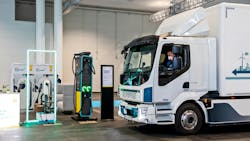Role of energy management in fleet electrification
For more on electrification infrastructure:
Many fleet operators approach electrification as a straightforward transition: swap combustion engines for electric batteries, install chargers, and move forward. But those who take this approach quickly discover that it is energy management, and not simply vehicles or charging stations, that can dictate the success or failure of the shift. Without a strategic approach to managing energy demand, costs can spiral, grid limitations can disrupt operations, and the expected benefits of fleet electrification, such as sustainability, cost savings, and operational efficiency, will evaporate.
Electricity is more than just fuel for EV fleets. It is a dynamic, fluctuating asset that, when properly managed, can reduce costs, improve efficiency, and generate revenue. Companies that integrate energy management into their electrification strategies will gain a decisive edge by optimizing fleet operations and dramatically improving their entire approach to power consumption.
The energy equation in fleet electrification
Unlike fossil fuels, electricity is not a static resource. Its pricing fluctuates based on grid demand, supply constraints, and time-of-use tariffs. A fleet of 50 electric buses can require as much power as a small town. And charging them at the wrong time can lead to soaring costs and unnecessary strain on the grid.
Energy costs are not just about consumption but also about when and how that energy is used. Some countries have capacity fees, while many utilities impose demand fees, which are payments based on the highest level of electricity drawn during a billing cycle. Such fees can add substantial costs, even if overall consumption remains within expectations.
Intelligent energy management solutions mitigate these risks. Advanced charging algorithms based on multiple previously siloed data sets, AI-driven predictive analytics, and grid-aware scheduling allow fleets to adjust charging patterns dynamically, reducing peak-time expenses and leveraging off-peak pricing to maximize savings.
Optimizing energy costs with smart charging and storage
Businesses that overlook the complexities of energy pricing risk significantly increasing their operational expenses. The ability to shift energy loads by scheduling vehicle charging during off-peak hours enables cost reductions. Balancing power demand across multiple chargers prevents excessive strain on the grid, reducing penalties for exceeding capacity limits. Some fleets are also incorporating on-site solar panels or battery storage to offset their reliance on the grid, further enhancing resilience and cost control.
Battery Energy Storage Systems (BESS) are critical in energy cost management. By storing energy when electricity prices are low and discharging it when prices peak, BESS allows fleet operators to minimize exposure to volatile energy markets. Additionally, stored energy can act as a buffer, be it within stationary batteries or within those in the electric vehicles themselves, ensuring that charging stations continue operating during grid disruptions.
Let’s look at the following scenario: If a depot has 20 vehicles, each using 50% of a 400-kWh battery daily, a business can cut energy costs by a third simply by moving charging from peak to off-peak hours. Under a fixed tariff of $0.30/kWh, the daily cost would be $1,200, but when switched to a day/night tariff and charging the fleet at night, the cost will drop to $800. This optimization, enabled by AI-driven energy management platforms, will help to improve cost control and enhance vehicle availability and operational efficiency. Additionally, by managing peak power demand, fleet operators can reduce the required capacity of power system equipment—such as transformers and switchgear— minimizing capital expenditure (CAPEX). Furthermore, lower peak demand translates to reduced capacity or demand fees, optimizing operational expenditure (OPEX) and ensuring a more cost-effective energy strategy.
Turning EV fleets into revenue generators
Traditionally, running an electric vehicle (EV) fleet has been viewed as a cost center - just another expense for businesses to manage. However, the rise of innovative grid technologies is transforming EV fleets into potential revenue generators, turning logistics centers into energy centers.
The key is flexibility. EV chargers and the vehicles themselves can act as flexible energy resources for the grid. Through smart charging algorithms, fleets can automatically adjust their electricity usage to support the grid during times of high demand. Crucially, these algorithms also ensure vehicles are ready for their next mission, identifying and "trading" any surplus flexibility without impacting fleet operations. This flexibility is incredibly valuable to utilities, who are willing to pay businesses that can help stabilize the grid.
There are two main ways EV fleets can capitalize on this flexibility:
1. Demand response programs
Utilities often offer financial incentives to businesses that reduce their energy consumption during peak demand periods. EV fleets equipped with BESS and smart energy management software can automatically adjust charging schedules or temporarily curtail charging. This allows them to earn rewards while also supporting grid stability, all without disrupting the readiness of vehicles for their next trip.
2. Vehicle-to-Grid (V1G or V2G) technology
Vehicle-to-Grid takes flexibility one step further. It enables EVs to manage either excess or scarce energy for the grid when it's needed most. This transforms EV fleets into mobile energy resources capable of earning revenue by either curtailing or discharging stored energy during high-demand times. Fleet operators can then use these grid-market earnings to offset their overall electricity costs, again without impacting the availability of vehicles.
By embracing the flexibility inherent in electrified fleets, and leveraging intelligent algorithms to manage that flexibility, businesses can turn a traditional cost center into a revenue-generating asset. The future of fleet electrification is not just about reducing emissions - it's about capitalizing on the grid services EVs can provide.
The importance of infrastructure readiness
While many businesses prioritize deploying charging stations, fewer consider the broader energy infrastructure required to support electrified fleets. Grid connectivity constraints can delay projects for months or even years if not addressed early. Power supply limitations, transformer capacity, and local grid reinforcement must all be factored into electrification planning.
Fleet operators must proactively collaborate with utility providers or independent producers to assess grid capacity, plan for necessary upgrades, and explore supplementary solutions such as microgrids. Microgrids are self-sustaining energy systems that can operate independently from the main grid and, when combined with BESS, electric fleets, and renewable energy sources, ensure fleets remain operational and efficient even during power outages.
A fleet of just five electric buses can require as much power as 500 households, illustrating the scale of infrastructure demands. It is therefore crucial to engage utilities early to ensure alignment on load management, grid updates, and demand response programs to ensure grid reliability while optimizing energy costs.
Strategies for scalable growth
There is no doubt that the adoption of EV fleets is set to grow substantially in the coming decade, which means the time for businesses to establish a scalable energy strategy is today. This requires designing electrification approaches for depots for future scalability to ensure infrastructure can support additional vehicles as fleets grow.
One sure way of anticipating and addressing energy system inefficiencies before they lead to costly downtime is by implementing predictive maintenance tools. For example, energy forecasting tools allow businesses to proactively adjust strategies based on market conditions, electricity pricing, and regulatory shifts.
AI-powered predictive analytics can assess real-time grid conditions, energy market fluctuations, and fleet charging needs, automatically optimizing costs and vehicle availability. Additionally, data will assist fleet operators to maximize efficiency through dynamic energy tariffs, peak shaving strategies, and real-time grid interaction.
Transforming energy for strategic advantage
Fleet electrification is more than replacing combustion engines with batteries; it is about reshaping the way businesses think about energy and viewing it as a strategic asset. Businesses that fail to integrate predictive energy analytics, dynamic charging strategies, and grid coordination into their electrification plans will soon find themselves facing escalating costs and operational bottlenecks. On the other hand, those who embrace energy management as a central pillar of their fleet strategy will cut costs and turn their EV investments into long-term financial and operational advantages.
About the Author

Alan White
Global Head
Alan White, as the global head of the Siemens Smart Infrastructure’s incubator Emerging Transportation Platforms, spearheads initiatives in eMobility, micro-grids, and sustainable energy for commercial fleets. With executive experience in renewable technologies and an innovator with AI patents to his name, Alan has been instrumental in smart grid advancements. His career highlights include influential roles at ENEL-X, eMotorWerks, and leadership positions at SupplyBase and other tech firms leading to successful exits.
Alan holds a BS from Union College and an MS from MIT Sloan School of Management. He actively contributes his expertise as an Advisor for UC-Berkeley SkyDeck Fund and participates on the board of several tech and energy firms.
